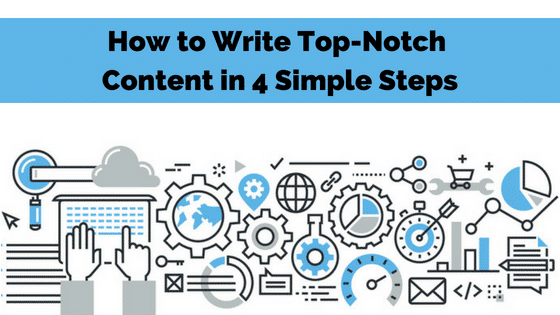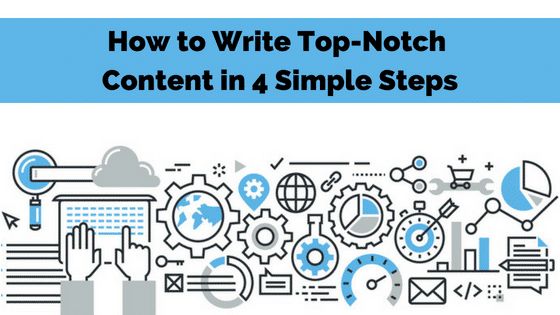
How to Write Top-Notch Content in 4 Simple Steps
From blog posts to original videos, your company’s branded content communicates your brand, solutions, and values to your audience.
Good content doesn’t just showcase your product, it helps potential customers solve their problems and build brand trust.
In an industry where 56% of customers buy from brands that relate to them, brands must prioritize producing original content.
Whether you’re a budding business or an established enterprise, you should be creating top-notch, original content.
Try these trends when creating a content strategy.

Know Your Audience
Before you outline a blog or brainstorm your podcast, consider your customers.
Converting them will require you to know who they are and what’s important to them.
You can (and should!) gather this information from a range of sources, including past orders, popular content, customer requests, website analytics, social listening tools, and user-generated data.
Content marketers and strategists use this data to create user personas that help them visualize their ideal customers.
Even without user data, you can answer simple questions about your audience:
- Where do they live (city, state, region, country)?
- What do they do for a living?
- Values, what is important to them?
- How does your business help solve problems your customers have?
- Where do they find content? What kind of content grabs their attention?
Knowing your audience can mean the difference between a trending blog post and a waste of resources.
Understanding your audience’s habits and needs helps you choose the best topics, formats, and platforms for your content—ultimately saving you time and money.
People respond to content that helps or empowers them to fix a problem, learn something new, or better their lives in some way.
Researching your audience helps you uncover your customers’ interests and pain points, so your content always makes an impact.
Write Powerful Headlines
You only have a few seconds to make an impression on your prospective reader.
Your headline should be compelling enough to catch their attention and promising enough to make them follow through on reading it.
No matter how excellent your content, potential customers won’t discover it behind a misleading or uninteresting headline.
Like anything else, there are tips and tricks to writing successful headlines.
Experiment with adding numbers, statistics, active verbs, and a sense of urgency to your headlines.
If you’re not seeing results, try testing additional headlines for every blog post or video, or add subheads to your headlines to convey additional meaning.
Your headline should always be unique, useful, and specific.
Your audience should understand the topic and format of your content before they ever click on it.
Use primary or descriptive keywords at the beginning of your headline to catch your reader’s attention.
Don’t be afraid to incorporate your brand’s voice or sense of humor into your headlines for a more personal touch.
Optimize for Keywords
Every content marketer, strategist, and writer knows about the importance of search engine optimization (SEO).
However, many still believe that SEO is about “writing for search engines”— or gaming a complex ranking system.
Optimizing your content with keywords benefits your readers too by helping them find relevant content.
More than 90% of internet users use search engines to find information.
Search engines like Google and Bing guide users to the best content for them based on factors like keyword usage, website authority, and brand trust.
Use keyword research to better understand what your target audience is searching for, so you can create relevant content they’d want to read.
Google Search Console, Moz Keyword Tool, and Google Trends let you research keywords that might be useful for your website.
Try these best practices when optimizing keywords.
- Opt for “long tailed keywords.” General keywords are more popular, which means they have more competition. Use longer, more descriptive phrases to attract your specific audience. Experiment with adding your location (city, state), the colors of your products, or your business’s niche.
- Optimize photos and videos. Photos and videos are great opportunities for keyword optimization, as they are also indexed by search engines. Always add relevant keywords to the titles and alt tags of images and videos.
- Maintain your metadata. Metadata tells search engines what your website is about, so it’s better ranked among your competitors. Add your keywords to page titles, headers, and descriptions to capture those rankings.
- Include your keywords in your content copy. Include your keywords and similar keywords to your content, but avoid “stuffing” your keywords into your text—this can make your copy difficult to read or index and you could get penalized for doing so. Integrate your keywords by including them in the title and where it makes sense on the page.
Use Pictures and Video
Visuals are an easy way to encourage engagement and draw attention to your content.
Posts with visuals receive 94% more page visits and engagement than those without.
In addition to attention, visual content helps your audience learn about your products, brand, or solutions.
Visual content like infographics and instructional videos are specifically designed to communicate interesting or helpful content in a manner that’s easier to follow and remember.
Try packaging your content with images or short videos (even GIFs!) to draw attention and help people remember your content.
Creating top-notch content is a process.
However, with time and dedication, businesses of all sizes can produce original, engaging content that converts readers to loyal customers.
Try these tips and don’t be afraid to experiment with how you best share your expertise with your audience and with others.
Tell us in the comments below: what do you use to create top-notch content your audience loves?







Pictures and videos are a MUST in any content, in ANY industry. They time and time again whether it’s with a company or individual business, drastically increase attention and conversion.
I’ve done some studies and found that people actually trust companies and business that post images more as well!
Awesome points throughout, thanks for the great post!
Hey thanks for the great insight! Content is key and visual content can do volumes for connecting with customers.
Hello there, That I would say is very good topic
It is necessary to build your content way better than other websites content to get more traffic.”Good content doesn’t just showcase your product, it helps potential customers solve their problems and build brand trust” I totally agree with it. And all you need is the best content writer.
Thanks for the input! Content is king and a solid writer can change your content strategy in amazing ways.